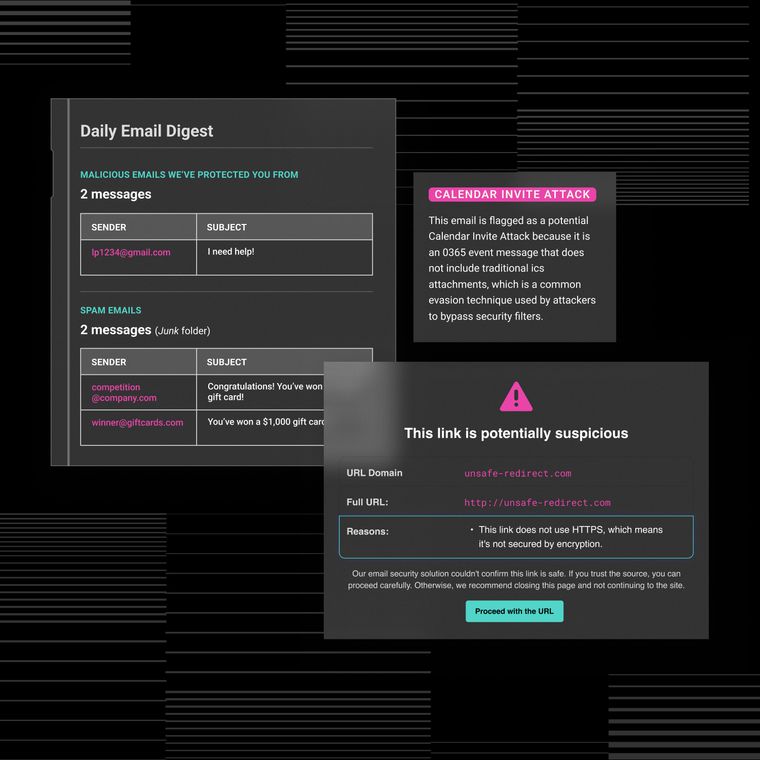The Complete Guide to SaaS Security for Protecting Your Cloud Applications
Learn Saas security best practices to protect your cloud applications and business data from evolving threats.
June 30, 2025
SaaS security protects organizations as cloud applications transform work environments. Employees connect their identities to many different SaaS services on a daily basis, creating multiple access points to sensitive information.
Traditional security approaches fail when data resides across multiple applications rather than within a protected network. Whether you manage SaaS security strategy, IT security operations, or regulatory compliance, effective SaaS security protects organizational assets while maintaining customer trust.
Understanding the Risks and Challenges in SaaS Security
SaaS applications create unique security challenges due to their distributed nature, easy adoption, and complex data-sharing capabilities.
SaaS Security Visibility Challenges and Shadow IT
Discovering all SaaS applications within an organization presents significant challenges. Unlike traditional software deployed by IT departments, employees can adopt SaaS apps using only email addresses and credit cards—creating "shadow SaaS."
This expands the attack surface without security team awareness. Many employees adopt SaaS tools without security involvement, and many companies lack comprehensive SaaS discovery capabilities. Organizations simply cannot secure applications they don't know about.
AI-powered SaaS tools compound this challenge. Employees may adopt AI-powered tools without oversight, which may bypass traditional monitoring and create data security risks.
Data Security and Access Control Risks in SaaS
SaaS environments feature constant data movement between applications, users, and third parties, rendering traditional network security ineffective.
Many of organizations experience widespread data oversharing and poor access control. These conditions create opportunities for data breaches and compliance violations.
Access management grows exponentially more complex in SaaS environments. Identities include both human users and app-to-app connections that multiply with AI and automation adoption.
Compliance and Regulatory Challenges in SaaS Security
SaaS products can create complex compliance requirements across standards like SOC 2, ISO 27001, GDPR, and HIPAA within multiple separate environments.
Primary compliance challenges include:
Data residency and cross-border data transfers
Maintaining consistent audit trails across multiple applications
Ensuring proper data handling and privacy controls throughout the SaaS ecosystem
Managing third-party risk when sharing data with SaaS providers
Non-compliance results in financial penalties and reputational damage.
Best Practices for SaaS Security
As SaaS becomes essential infrastructure for modern business, specialized security strategies protect these environments effectively.
Implement Comprehensive SaaS Security Visibility and Discovery
Security requires visibility. To establish this foundation:
Create and maintain a complete inventory of all SaaS applications
Implement continuous SaaS discovery processes
Develop a formal SaaS approval process balancing security and user needs
Deploy SaaS security posture management tools for ongoing visibility
SaaS discovery and security posture management reveal the actual applications accessing organizational data.
Adopt Identity-Centric SaaS Security Measures
Employees are connecting to more and more SaaS services, creating numerous potential entry points for attackers.
To secure these identities:
Require effective multi-factor authentication across all SaaS applications
Apply behavioral analysis to identify unusual user activity and prevent account takeovers
Implement least privilege access principles
Regularly review privileges for both human and non-human identities
Behavioral analysis effectively identifies sophisticated threats. Implementing robust identity defense strategies is crucial to protect against modern threats.
Establish SaaS Data Protection Frameworks
Data sprawl affects tons organizations that experience widespread data oversharing.
To control this sprawl:
Classify and monitor data across all SaaS applications
Enforce encryption for data at rest and in transit
Deploy SaaS-specific data loss prevention strategies
Assess risks when sharing data with SaaS providers
Create secure data backup and recovery practices
Develop Proactive SaaS Security Threat Detection and Response
With increasing SaaS breaches, organizations require proactive protection approaches.
Effective strategies include:
Implementing AI-driven security solutions that detect sophisticated threats using advanced threat detection strategies
Deploying security monitoring across email, collaboration tools, and other SaaS platforms
Creating incident response procedures specifically for SaaS security incidents
Conducting regular security testing against SaaS environments
AI-powered security identifies threats that humans and rule-based systems miss. Abnormal's behavioral AI platform detects multi-channel attacks by correlating activity across various SaaS applications to identify complex threat patterns.
Evaluating SaaS Security Solutions
Selecting appropriate security solutions for SaaS environments significantly impacts organizational security posture. As threats evolve, evaluation must focus on capabilities, integration options, and real-world effectiveness.
Essential SaaS Security Capabilities to Consider
When evaluating SaaS security solutions, prioritize these features:
Behavioral Analysis and Anomaly Detection: Select solutions that establish organizational baselines and flag deviations. This approach identifies sophisticated attacks that rule-based systems miss.
Multi-Channel Coverage: Choose solutions that monitor email, collaboration tools (like Slack and Microsoft Teams), and other SaaS applications to detect attacks that move between platforms.
AI-Powered Threat Intelligence: Effective tools use AI to process threat data in real-time, staying ahead of new attack patterns and reducing manual update requirements.
Automated Remediation: Solutions that automatically terminate suspicious sessions or revoke access minimize damage by reducing response time from hours to seconds.
Low False Positive Rates: Quality behavioral analysis produces high-confidence alerts, reducing alert fatigue and focusing team attention on genuine threats.
Integration and Deployment Considerations for SaaS Security
Security tools require effective integration to provide value. Integration considerations become even more critical when attempting to protect remote workforces. Consider these factors:
API-Based Integration: Solutions using API-based integrations typically deploy in minutes without complex mail flow changes or manual configurations. This approach integrates seamlessly with platforms like Microsoft 365 and Google Workspace.
Broad Platform Support: Ensure solutions integrate with existing security infrastructure, including SIEM, SOAR, and identity management tools.
Minimal Disruption: Select solutions that maintain current workflows without requiring extensive retraining.
Scalability: Solutions should accommodate organizational growth, handling new users and applications as SaaS adoption expands.
Assessing Vendor SaaS Security Posture
Security vendors must demonstrate strong security practices. When evaluating vendors:
Compliance Certifications: Verify relevant certifications including SOC 2, ISO 27001, and industry-specific requirements.
Data Protection Measures: Request detailed information about data security, including encryption practices and access controls.
Incident Response Capabilities: Assess their security incident management, including communication protocols and recovery processes.
Regular Security Assessments: Confirm they conduct security testing through audits and penetration testing.
Transparency: Select vendors who provide transparency about security architecture and processes.
Enhance Your SaaS Security with Abnormal
SaaS security differs fundamentally from traditional IT security. The widespread adoption of cloud applications has transformed protection requirements from centralized to distributed security models.
The practices covered—from comprehensive visibility to AI-powered threat detection—help balance productivity with security. Focusing on identities, implementing robust data protection, and deploying behavioral analysis significantly strengthens SaaS security posture.
Effective SaaS security combines advanced technology with appropriate processes and educated users. The most secure organizations integrate cutting-edge security tools with user awareness and clear governance policies.
As threats evolve, particularly with attackers leveraging AI capabilities, staying ahead requires security that anticipates threats before materialization. Forward-thinking solutions leverage behavioral AI and machine learning to identify subtle anomalies before they become breaches.
Abnormal Security's approach to SaaS protection exemplifies this strategy. By analyzing communication patterns, user behaviors, and contextual signals across multiple channels, their platform detects early compromise indicators that traditional security misses.
Modern threats require modern defenses. To see how Abnormal protects your SaaS environment, book a demo with Abnormal to experience how their platform provides comprehensive protection for your SaaS ecosystem against today's complex threats.
Related Posts
Get the Latest Email Security Insights
Subscribe to our newsletter to receive updates on the latest attacks and new trends in the email threat landscape.


